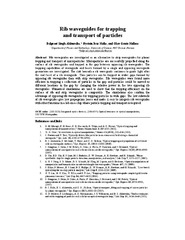Optical Forces, Waveguides and Micro Raman Spectroscopy
Permanent lenke
https://hdl.handle.net/10037/5151Dato
2012-12-21Type
Doctoral thesisDoktorgradsavhandling
Forfatter
Løvhaugen, PålSammendrag
Optical waveguides are used to confine propagating light. In a dielectric waveguide, a small part of the propagating light travels along and just outside the waveguide surface. This evanescent field can interact with objects on the waveguide surface. Two effects of this light-matter interaction are presented, optical forces and Raman scattering.
Optical forces are caused by changes in the momentum of radiation. The forces are exerted on objects interacting with a propagating field. The magnitude of the force is dependent on the difference in permittivity and permeability between the object and the surrounding medium. The forces can be used to trap and control micro- and nanoparticles.
In Raman scattering, the scattered field exchanges energy with the scatterer. The amount of energy that is lost or gained depends on the molecular structure of the scatterer. By collecting the spectra of the scattered light, the molecules in the scatterer can be analyzed and characterized.
Two numerical studies have been performed to simulate optical forces on a range of micrometer-sized objects trapped and propelled on a waveguide. A numerical model of a hollow glass sphere provides new insights on how the optical force depends on the glass thickness. A numerical model of a red blood cell studies the force dependence on cell shape and refractive index. A model of a real-sized cell is made.
Two experimental studies have used Raman spectroscopy to characterize and analyze objects subject to optical forces. One study looks at the viability of using Raman scattering to characterize objects trapped on waveguides. It was found that characterization with Raman spectroscopy is viable with the use of an external, focused light source, while excitation using the evanescent field is difficult. A second study investigates a new technique for proliferation measurements of non-adherent cells. A combined optical trapping–Raman spectroscopy setup is used to show that a Raman probe can be used to measure proliferation of actively replicating cells, even in a sample were the cell growth is slow or negative.
The presented studies were performed to investigate the potential of combining characterization with optical trapping on waveguides. This could be of use in an optical lab-on-a-chip for cells.
Forlag
Universitetet i TromsøUniversity of Tromsø
Metadata
Vis full innførselSamlinger
Copyright 2012 The Author(s)
Følgende lisensfil er knyttet til denne innførselen:
Med mindre det står noe annet, er denne innførselens lisens beskrevet som Attribution-NonCommercial-ShareAlike 3.0 Unported (CC BY-NC-SA 3.0)
Relaterte innførsler
Viser innførsler relatert til tittel, forfatter og emneord.
-
Rib waveguides for trapping and transport of particles
Ahluwalia, Balpreet Singh; Helle, Øystein Ivar; Hellesø, Olav Gaute (Journal article; Tidsskriftartikkel; Peer reviewed, 2016-02-23)Rib waveguides are investigated as an alternative to strip waveguides for planar trapping and transport of microparticles. Microparticles are successfully propelled along the surface of rib waveguides and trapped in the gap between opposing rib waveguides. The trapping capabilities of waveguide end facets formed by a single and opposing waveguide geometries are investigated. The slab beneath a rib ... -
Optical transport, lifting and trapping of micro-particles by planar waveguides
Helle, Øystein Ivar; Ahluwalia, Balpreet Singh; Hellesø, Olav Gaute (Journal article; Tidsskriftartikkel; Peer reviewed, 2015-03-03)Optical waveguides can be used to trap and transport micro-particles. The particles are held close to the waveguide surface by the evanescent field and propelled forward. We propose a new technique to lift and trap particles above the surface of the waveguides. This is made possible by a gap between two opposing, planar waveguides. The field emitted from each of the waveguide ends diverge fast, away ... -
On-chip optical nanoscopy: towards high throughput and multi-modality
Helle, Øystein Ivar (Doctoral thesis; Doktorgradsavhandling, 2019-11-07)Super-resolution microscopy techniques improve the resolution of the optical microscope beyond the diffraction limit of light. A range of different techniques demands different optical configurations and clever illuminating strategies to enhance the resolution. This has led to the development of advanced instrumentation, where the super-resolution mechanisms are adding both cost and bulk to the ...


 English
English norsk
norsk



